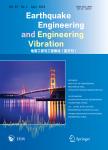Dynamic property tests of frozen red sandstone using a split hopkinson pressure bar
Dynamic property tests of frozen red sandstone using a split hopkinson pressure bar作者机构:Institute of Mechanics and Civil EngineeringChina University of Mining and TechnologyBeijing
出 版 物:《Earthquake Engineering and Engineering Vibration》 (地震工程与工程振动(英文刊))
年 卷 期:2019年第18卷第3期
页 面:511-519页
核心收录:
学科分类:07[理学] 0818[工学-地质资源与地质工程] 0815[工学-水利工程] 0813[工学-建筑学] 0802[工学-机械工程] 0814[工学-土木工程] 0801[工学-力学(可授工学、理学学位)]
基 金:National Natural Science Foundation grant project(41572270)
主 题:SHPB negative temperature frozen red sandstone dynamic compressive strength constitutive model
摘 要:In this study, frozen red sandstone specimens were impacted by a Split Hopkinson bar (SHPB), with a velocity of 4.558 ~ 6.823 ms-1. The temperature of the specimens was maintained at -15℃ during the experiment. For comparison purposes, static uniaxial compression tests were conducted in advance using a freezing triaxial test machine. Four stress-strain curves were obtained in diff erent average strain rates. The test results suggested that when the average strain rate is low, the specimen strength changes gradually;but when it is high, its strength changes rapidly. When the average strain rate is 120.73 s-1, the peak value of stress is as high as 82.96 MPa, which is about two times that of the static compressive strength of 44.1 MPa. A constitutive model was established that was composed of the damaged, viscoelastic and spring bodies, and revealed the variations of compressive strength and strain for the frozen red sandstone under diff erent high strain rates. The test results also showed that the failure form was correlated to the average strain rate of the frozen red sandstone. When the average strain rate is low, the damage was only distributed on the specimen’s edges. However, as the average strain rate increases, the damage range extended to the central parts of the specimen. When the average strain rate reached 107.34s-1, the specimen was smashed.



